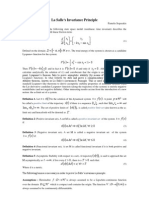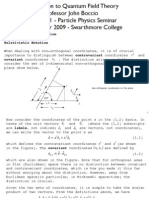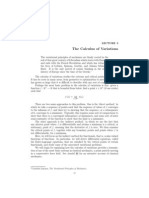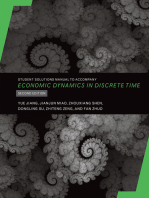Phase
Phase
Uploaded by
Utkal Ranjan MuduliCopyright:
Available Formats
Phase
Phase
Uploaded by
Utkal Ranjan MuduliOriginal Description:
Copyright
Available Formats
Share this document
Did you find this document useful?
Is this content inappropriate?
Copyright:
Available Formats
Phase
Phase
Uploaded by
Utkal Ranjan MuduliCopyright:
Available Formats
Project for Math 224 Phase Plane Analysis on a Reaction System Phase plane analysis is a very useful tool
to understand the qualitative behavior of solutions of systems of rst order autononous systems: dx = f (x, y ), dt (1) dy = g (x, y ). dt Such systems frequently arise in physics, chemistry and mathematical biology. On the other hand, there is rich and beautiful mathematics behind these systems. The text book gives a good introduction on this and the purpose of this project is to, through a concrete reaction model, further introduce various mathematical ideas and tools in phase plane analysis. The reaction model. Consider a reaction mechanism
1 2 3 4 A X B, C Y, X + X + Y 3X,
1 where A X means that the chemical A decays into the chemical X at a rate
proportional to the amount of A present, with proportionality constant k1 ; similarly,
4 X + X + Y 3X means that two X molecules and one Y molecule combine to
form three X molecules at a rate proportional to the product of present amount of Y and the square of the present amount of X , with proportionality constant k4 . We measure the amount of a chemical by concentration in, say, mols/liter. (a) Let x(t) and y (t) be the amounts of X and Y chemicals at time t, respectively. Using the Law of conservation of Mass (net rate of change = rate in - rate out), show that x(t) and y (t) satisfy the following system of 1st order ODEs: dx = k1 a k2 x + k4 x2 y, dt (2) dy = k3 c k4 x2 y, dt 1
where a and c are the amount of chemicals A and C , respectively. From now on, assume that chemicals A and C are supplied so that a and c are kept constant. To beautify the system (2), introduce new dependent variables: u(t) = c1 x(c2 t), v (t) = c3 y (c2 t), where c1 , c2 , c3 are positive constants. (b) Choose c1 , c2 , c3 suitably so that the new unknowns u(t) and v (t) satisfy the beautied system du(t) = m u + u2 v, dt (3) dv (t) = n u2 v, dt where m and n are some positive constant multiple of a and b. (This procedure is called rescaling or non-dimensionalization of (2).) The starting point of phase plane analysis is always to nd equilibrium point(s) and the nullclines, because they are deterministic to the phase portrait. (c) Find the nullclines and the equilibrium point of (3). The nullclines devide the rst quadrant of uv -plane into four regions (since both u and v 0 by physical considerations, we focus on the 1st quadrant). In each of these regions, draw an arrow indicating the direction of orbits. Denote the equilibrium point found in (c) by (uo , vo ). The next thing to do is to study the behavior of orbits near the equilibrium point: we want to know if the equilibrium point is a sink, a source, a saddle or a center, etc. These properties of the equilibrium point are local in nature, i.e., they concern what happens in a small neighborhood of the point. By using the tangent plane approximation for the right hands of (3) (denoted by f (u, v ) and g (u, v ) respectively) near (uo , vo ), we obtain the linearized system dx f f = (u0 , v0 )x + (u0 , v0 )y dt u v dy = g (u , v )x + g (u , v )y 0 0 0 0 dt u v 2
(4)
Notice that (0, 0) is an equilibrium point of (4) and it corresponds to the equilibrium point (u0 , v0 ) of (3). We expect that the orbits of (4) near the origin resemble those of (3) near (u0 , v0 ). For examples, if the orbits of (4) spirals towards (0, 0), so do the orbits of (3) near (u0 , v0 ). However, if the orbits of (4) are cycles (closed curves), the orbits of (3) near (u0 , v0 ) may be cycles, or spirals (inward or outward). Our expectation is half right and half wrong. In class, you already learned when this expectation can go wrong. We state the following positive result that applies to the general system (1) with nice f and g . Theorem 1. Consider system (1). Assume all the second partial derivatives of f (x, y ) and g (x, y ) be continuous. Let (x0 , y0 ) be an equilibrium point of (1). If the equilibrium point (0, 0) of the linearized system is a sink, spiral sink, a source, a spiral source, or a saddle, so is the equilibrium point (x0 , y0 ) of (1), respectively. Denition. When an equilibrium point is a sink or spiral sink, it is said to be asymptotically stable; when it is a source or a spiral source or a saddle, it is said to be unstable. You already know that for linear homogeneous systems, (5) where y = x , A= y a, b , a d constants, c, d dy = Ay dt
the signs of the real parts of the eigenvalues of matrix A determine the type of the equilibrium point (0, 0). They obviously depend on (m, n). Presumably, there are several regions on the rst quadrant of the m n plane, on each of which the equilibrium point (x, y ) = (0, 0) (and hence (u, v ) = (u0 , v0 )) is of one type (say, spiral sink). However, it would be hard for you if we want to distinguish sinks(with straight-line solutions) from the spiral sinks, sources from spiral sources: if we know that the real parts of all two eigenvalues are negative, then we know for sure that the equilirium point is either a sink or a spiral sink and hence asymptotically stable, and the similar thing can be said for sources and spiral sources(that is, when the point is unstable). 3
We will content ourselves with the following: nd the regions on the rst quadrant of the m n plane on each of which the equilirium point (u, v ) = (u0 , v0 ) of (3) is either asymptotically stable or unstable. As said above, the signs of the real parts of the eigenvalues are crucial for stability and instablity. To study them directly for the present problem, you will sink into morass of nasty calculations. The following two results are elegant and can keep dry. (d) Let 1 and 2 be the eigenvalues of A. Show that (6) 1 + 2 = a + d, 1 2 = a, b . c, d
(a + d is called the trace of A and is denoted by T rA). (e) Show now that if detA > 0 and T rA >, then the real parts of 1 and 2 are positive; if detA > 0 and T rA < 0, then the real parts are negative. What if detA < 0? Now you can tackle the stability question of the equilibrium point (u0 , v0 ) of the reaction system (3). (f) Show that if (7) n m > (m + n)3
then the equilibrium point (u0 , v0 ) of (3) is unstable. (g) Show that if (8) n m < (m + n)3 ,
then the equilibrium point (u0 , v0 ) of (3) is asymptotically stable. (h) Now we realize that the equation (9) n m = (m + n)3 4
is the borderline condition for stability and instability. Sketch the curve represented by (9) in the rst quadrant of the m n plane. Indicate the region of instability, i.e., the region represented by the inequality (8). Now we know that if (m, n) is outside that region of instability all orbits of (3) nearby (u0 , v0 ) converge to (u0 , v0 ) as t , and if (m, n) is inside the region, all these orbits move away from (u0 , v0 ). A natural and interesting question arises: in the latter case, where do these orbits go in the long run? It turns out that these orbits will spiral towards a cycle, called limiting cycle :
(i) Sketch on t u or t v plane the curves of u(t) and v (t) which correspond to the orbit drawn above. (Your curves should be oscillatory because the orbit converges to a limiting cycle.) Terminology: When the parameters (m, n) move from the region of stability into the region of instablity, the type of the equilibrium changes and thus a bifurcation occurs. In fact, a limiting cycle suddenly emerges when (m, n) crosses into the region of instability. In this scenario, we say a Hopf bifurcation occurs. Now lets see why when (m, n) is in the region of instability, orbits of (3) near (u0 , v0 ) converge to a limiting cycle. To this end, we need the following beautiful Poincar e-Bendixson Theorem. Consider system (1) where f (x, y ) and g (x, y ) are nice in the sense that all their 1st order partials are continuous. Suppose (1) has only one equilibrium point (x0 , y0 ). Then any bounded orbit (that is, the orbit is always inside 5
a square of xed size), either converges to (x0 , y0 ) or spirals towards a limiting cycle as t , or the orbit itself is a cycle. A very important condition in the above theorem is the boundedness of the orbit. To verify this condition, we use a simple and yet powerful device, called invariant region . An invariant region of system (1) is a region in x y plane on whose boundary the vector (f (x, y ), g (x, y )) always points into the region:
Any orbit that starts inside an invariant region will be conned in it forever: it will never
dy cross the boundary because there the tangent vector ( dx dt , dt ) of the orbit points into the
region. (j) For our system (3), show that the following shaded rectangular region (innite long) is an invariant region.
(k) Show that any orbit of (3) that starts inside the 1st quadrant is bounded. Hint: (Adjust the height of the invariant region discussed in (l) so that it contains (u(0), v (0)). Then the orbit will be conned in the region. So the only way for the orbit to be unbouned is to go far away to the right in the region. This cant happen. Here is why: adding the two 6
equations in (3) we get d(u + v ) = (m + n) u. dt so if u > m + n, (u + v )(t) is decreasing. So ....) Now we are ready to apply the Poincar e-Bendixson Theorem to (l) Show when (m, n) is in the region of instability, i.e. when m and n satisfy (12), every orbit of (3) near (u0 , v0 ) spirals towards a limiting cycle. Hint:By virtue of Poincar e-Bendixson, you only need to rule out the case that the orbit converge to (u0 , v0 ) as t goes to and the case that the orbit is a cycle. (m) Computer simulations: Use Matlab to draw the phase portraits of (3) in each of the following cases: (i) n = 0.5, m = 0.5; (ii) n = 0.5, m = 0.05. Use the portraits to illustrate the above results of stability, instability and the presence of limiting cycles (as discussed in parts (f), (g) and (l)). When using Matlab, you should adjust the ranges for x and y so that your portraits show the relevant phenomena clearly . For (m, n) inside the region of stability, try to nd two sets of values for (m, n) so that the equilirium point is a sink with straight-line solutions, and a spiral sink, respectively.
You might also like
- Lecture 1Document5 pagesLecture 1johnte vokeNo ratings yet
- Two-Body Problems With Drag or Thrust: Qualitative ResultsDocument15 pagesTwo-Body Problems With Drag or Thrust: Qualitative Resultsrsanchez-No ratings yet
- Fundition ChaosDocument25 pagesFundition ChaosRogério da silva santosNo ratings yet
- Section A: Pure MathematicsDocument7 pagesSection A: Pure MathematicshmphryNo ratings yet
- Tarea 3 EDO 2024-2Document4 pagesTarea 3 EDO 2024-2faroeldrNo ratings yet
- Physics 131 HW 1 SolnDocument8 pagesPhysics 131 HW 1 SolnIgnacio MagañaNo ratings yet
- Set 11Document15 pagesSet 11agosztNo ratings yet
- Nonl MechDocument59 pagesNonl MechDelila Rahmanovic DemirovicNo ratings yet
- Chaos Lecture NotesDocument16 pagesChaos Lecture Notessl1uckyNo ratings yet
- Hand Out FiveDocument9 pagesHand Out FivePradeep RajasekeranNo ratings yet
- Problem Set VI Lagrangian DynamicsDocument4 pagesProblem Set VI Lagrangian DynamicsDiego ForeroNo ratings yet
- Problem Set 6Document4 pagesProblem Set 6James ConnaughtonNo ratings yet
- A Generalized Prey-Predator Model: Letters To The EditorDocument4 pagesA Generalized Prey-Predator Model: Letters To The EditorGNo ratings yet
- A. H. Taub - Relativistic Fluid MechanicsDocument33 pagesA. H. Taub - Relativistic Fluid MechanicsJuaxmawNo ratings yet
- Surfaces Part2Document10 pagesSurfaces Part2Gemechis NezirNo ratings yet
- Unit 1Document18 pagesUnit 1cooooool1927No ratings yet
- Liapunov's Second MethodDocument6 pagesLiapunov's Second Methodsalim100% (1)
- Nonlinear Dynamics-And-Chaos-StrogatzDocument9 pagesNonlinear Dynamics-And-Chaos-Strogatzali.sahebiNo ratings yet
- Electromagnetic Field TheoryDocument73 pagesElectromagnetic Field Theoryajas777BNo ratings yet
- Non-Linear Strogatz 4Document4 pagesNon-Linear Strogatz 4Oscar CordobaNo ratings yet
- Notes PDFDocument59 pagesNotes PDFnajera_No ratings yet
- Unit 7Document17 pagesUnit 7Rishabh SinghNo ratings yet
- Einstein's Simple Derivation of Lorentz Transformation: A CritiqueDocument9 pagesEinstein's Simple Derivation of Lorentz Transformation: A CritiqueGustavo ArciniegaNo ratings yet
- Behaviour of Nonlinear SystemsDocument11 pagesBehaviour of Nonlinear SystemsCheenu SinghNo ratings yet
- Glimm-1965-Communications On Pure and Applied MathematicsDocument19 pagesGlimm-1965-Communications On Pure and Applied Mathematicsnickthegreek142857No ratings yet
- LaSalle in Variance PrincipleDocument5 pagesLaSalle in Variance PrinciplechvngNo ratings yet
- Coordinate Systems and Transformations: TopicsDocument19 pagesCoordinate Systems and Transformations: TopicshdphimxemNo ratings yet
- Differentiable Manifolds: Nigel HitchinDocument30 pagesDifferentiable Manifolds: Nigel HitchinEmkafsNo ratings yet
- Assignment 1 (2016) SolutionDocument3 pagesAssignment 1 (2016) SolutionShambhavi SinghNo ratings yet
- Vyg FJutwx ZD Ov IV7 AfwnDocument84 pagesVyg FJutwx ZD Ov IV7 AfwnAllyson DianeNo ratings yet
- HW 2Document3 pagesHW 2Prajita RoyNo ratings yet
- Isometries of RNDocument5 pagesIsometries of RNfelipeplatziNo ratings yet
- Population Growth: Flows O N The LineDocument6 pagesPopulation Growth: Flows O N The LineRaúl Baigorri MartínezNo ratings yet
- Problem Sheet 2Document4 pagesProblem Sheet 2Qingpo WuwuNo ratings yet
- NLW L15Document25 pagesNLW L15renatobellarosaNo ratings yet
- Exercises: Waves in SpaceDocument3 pagesExercises: Waves in SpaceKazaValiShaikNo ratings yet
- Unit-10 by Cambridge University Learning LessonDocument21 pagesUnit-10 by Cambridge University Learning Lessondragonthegreat214No ratings yet
- Stability LinearizationDocument5 pagesStability LinearizationDiego BastidasNo ratings yet
- Moire PDFDocument10 pagesMoire PDFIngrid Margeli NuñezNo ratings yet
- CatenaryDocument8 pagesCatenaryMary MarasiganNo ratings yet
- Thompson1987.pdf Boundary ConditionsDocument24 pagesThompson1987.pdf Boundary ConditionsRaul Martinez JardonNo ratings yet
- Special Relativity: Massachusetts Institute of TechnologyDocument18 pagesSpecial Relativity: Massachusetts Institute of TechnologymarioasensicollantesNo ratings yet
- Anomalous Relaxation Oscillations Due To Dynamical Traps: I.A. Lubashevsky, V.V. Gaychuk, A.V. DemchukDocument9 pagesAnomalous Relaxation Oscillations Due To Dynamical Traps: I.A. Lubashevsky, V.V. Gaychuk, A.V. DemchukvagafNo ratings yet
- Hyperbolicity Versus Partial-Hyperbolicity and The Transversality-Torsion Phenomenon by Jacky CRESSON & Christophe GUILLETDocument11 pagesHyperbolicity Versus Partial-Hyperbolicity and The Transversality-Torsion Phenomenon by Jacky CRESSON & Christophe GUILLETcmpmarinhoNo ratings yet
- 6.7 Introduction Dynamics in Three Dimensions A. General PrinciplesDocument12 pages6.7 Introduction Dynamics in Three Dimensions A. General PrincipleselvyNo ratings yet
- QFT BoccioDocument63 pagesQFT Bocciounima3610No ratings yet
- Agmon 1954Document11 pagesAgmon 1954anil.newscientistNo ratings yet
- Lorentz EinsteinDocument7 pagesLorentz Einsteinektanu1No ratings yet
- The Calculus of VariationsDocument52 pagesThe Calculus of VariationsKim HsiehNo ratings yet
- Waves On A String: Physical MotivationDocument17 pagesWaves On A String: Physical MotivationMinh Ngọc PhanNo ratings yet
- Koshlyakov, Smirnov, Gliner - Differential Equations of Mathematical Physics - 1964Document8 pagesKoshlyakov, Smirnov, Gliner - Differential Equations of Mathematical Physics - 1964ceyrangulhuseynovaNo ratings yet
- Rigid Body RotationDocument7 pagesRigid Body RotationShyamalNo ratings yet
- Topological Approach To Chain Recurrence in Continuous Dynamical SystemsDocument8 pagesTopological Approach To Chain Recurrence in Continuous Dynamical SystemsAbdullah BoufousNo ratings yet
- Control of Chaos Applied To Earth-Moon TransfersDocument6 pagesControl of Chaos Applied To Earth-Moon TransfersavNo ratings yet
- Catenary Cable TheoryDocument7 pagesCatenary Cable TheorytdfsksNo ratings yet
- Levinson Elasticity Plates Paper - IsotropicDocument9 pagesLevinson Elasticity Plates Paper - IsotropicDeepaRavalNo ratings yet
- Assignment EwtDocument19 pagesAssignment Ewtjishnu mohananNo ratings yet
- Preliminaries: What You Need To Know: Classical DynamicsDocument5 pagesPreliminaries: What You Need To Know: Classical Dynamicsclarkalel1No ratings yet
- Representations of The Symmetry Group of SpacetimeDocument29 pagesRepresentations of The Symmetry Group of SpacetimemarioasensicollantesNo ratings yet
- Student Solutions Manual to Accompany Economic Dynamics in Discrete Time, second editionFrom EverandStudent Solutions Manual to Accompany Economic Dynamics in Discrete Time, second editionRating: 4.5 out of 5 stars4.5/5 (2)
- LESSON 2.11 Understanding ElasticityDocument12 pagesLESSON 2.11 Understanding Elasticitychekgu_2007No ratings yet
- Dyneema Creep - Mooring RopesDocument12 pagesDyneema Creep - Mooring Ropesgiselabration100% (1)
- Derivation of BLUE Property of OLS EstimatorsDocument4 pagesDerivation of BLUE Property of OLS Estimatorsanksingh08100% (2)
- Recommended RC Jacket Thickness and Reinforcement Used in Repair of RC Spirally Reinforced Concrete Column Partially And2Document5 pagesRecommended RC Jacket Thickness and Reinforcement Used in Repair of RC Spirally Reinforced Concrete Column Partially And2Magdy BakryNo ratings yet
- 117ez - Metrology and Surface Engineering PDFDocument8 pages117ez - Metrology and Surface Engineering PDFvenkiscribd444No ratings yet
- Fiitjee: Sample PaperDocument20 pagesFiitjee: Sample PaperYash100% (1)
- Adinkra Symbol MathematicsDocument18 pagesAdinkra Symbol MathematicsJ. LeonNo ratings yet
- Fluid Mechanics - Lecture 7 - 9 - Viscous + NNF Pipe FlowxDocument61 pagesFluid Mechanics - Lecture 7 - 9 - Viscous + NNF Pipe Flowxking4lifeNo ratings yet
- Transmission Conductors SouthwireDocument5 pagesTransmission Conductors SouthwireGunji Venkata Srinivasa BabuNo ratings yet
- The Origin of LifeDocument20 pagesThe Origin of LifePetruta Calina CorneaNo ratings yet
- Pieas 2016 Test ResponsesDocument13 pagesPieas 2016 Test ResponsesArbab HaiderNo ratings yet
- 2010 Panagiotaki Et Al. Lecture Notes in Computer Science PDFDocument8 pages2010 Panagiotaki Et Al. Lecture Notes in Computer Science PDFAjayaKumarKavalaNo ratings yet
- Orifice Prelim 2Document14 pagesOrifice Prelim 2Kyle NguyenNo ratings yet
- First Order Differential Equation (Applications)Document18 pagesFirst Order Differential Equation (Applications)shailendra_iitg100% (22)
- Gold ProblemsDocument13 pagesGold ProblemsoitlaliNo ratings yet
- 24 ME154 Fatigue Failure2 Sp12Document11 pages24 ME154 Fatigue Failure2 Sp12Gautam BandyopadhyayNo ratings yet
- Project FoundationDocument39 pagesProject FoundationAlyfer del RosarioNo ratings yet
- Ecodis P 90Document2 pagesEcodis P 90Gustavo E Aguilar ENo ratings yet
- Curriculum Vitae: Dr. Syed Sibte Asghar AbidiDocument5 pagesCurriculum Vitae: Dr. Syed Sibte Asghar AbidiDesh BhaktNo ratings yet
- Physics Homework 8Document7 pagesPhysics Homework 8Petra Elang PradanaNo ratings yet
- Toc Pmt1944-Eng Snl2019Document8 pagesToc Pmt1944-Eng Snl2019Vignesh WaranNo ratings yet
- Mat 113 Differential CalculusDocument3 pagesMat 113 Differential CalculusVincent OduorNo ratings yet
- Analytical Methods For Lipases Activity Determination - A ReviewDocument8 pagesAnalytical Methods For Lipases Activity Determination - A ReviewgotcanNo ratings yet
- AlginateDocument34 pagesAlginateRebin AliNo ratings yet
- KAN Pd-01.04 Interpretation N Guidance On Estimation Uncertainty Measurement in TestingDocument19 pagesKAN Pd-01.04 Interpretation N Guidance On Estimation Uncertainty Measurement in Testingwahyuni buamonaNo ratings yet
- Aashto TP 70-2007Document7 pagesAashto TP 70-2007Leonardo JaimesNo ratings yet
- Matematica en Contexto V - Manual de Referencia 10 09Document83 pagesMatematica en Contexto V - Manual de Referencia 10 09José Luis Aybar RomeroNo ratings yet
- ME and MSE Sinclair / Wright State Transfer GuideDocument1 pageME and MSE Sinclair / Wright State Transfer GuideAdamNo ratings yet























































































